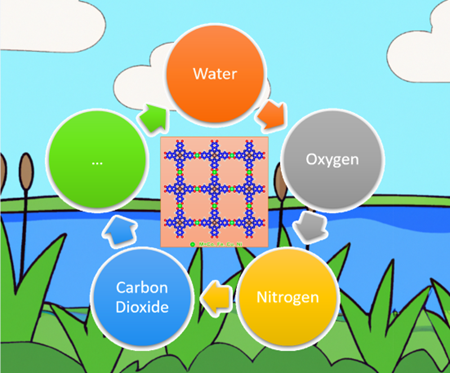

Conductive Phthalocyanine-Based Metal-Organic Frameworks for Efficient Electrocatalysis
Received date: 2023-11-21
Revised date: 2024-01-15
Online published: 2024-01-26
Supported by
National Natural Science Foundation of China(52131003)
National Natural Science Foundation of China(52122007)
National Natural Science Foundation of China(52200076)
Specific Research Fellowship of Chinese Academy of Sciences(E329620101)
Natural Science Foundation of Chongqing(cstb2022nscq-bhx0035)
The development of innovative catalysts for various electrochemical scenarios is crucial in satisfying the growing demands for sustainable energy and environmental conservation. Conductive metal-organic frameworks (c-MOFs) based on phthalocyanine complexes known as phthalocyanine-based c-MOFs, have shown promising potential in electrochemical energy conversion and environmental research. These c-MOFs represent a new category of layer-stacked porous MOFs with in-plane extended π-conjugation structure, which can enhance electrocatalytic activity by facilitating the mass diffusion of reactants and electron/charge transfer. The exceptional promising for a variety electrocatalytic reactions, such as water, oxygen, CO2, and nitrogen conversion. In this work, we focus primarily on phthalocyanine-based c-MOFs rather than other types of c-MOFs, providing a comprehensive overview of their conductive mechanisms and main electrocatalytic reactions. We also cover recent progress in the utilization of phthalocyanine-based c-MOFs as heterogeneous catalysts in electrocatalysis. Furthermore, we explore the challenges related to the utilization of phthalocyanine-based c-MOFs in electrocatalysis. The state-of-the-art research and insights into the future perspectives of phthalocyanine-based c-MOFs as electrocatalysts are also presented and discussed. This work aim to guide the development of phthalocyanine-based c-MOF electrocatalysts with enhanced activity.
1 Introduction
2 Conductive mechanisms
3 Electrocatalysis
3.1 Water electrolysis
3.2 Oxygen reduction reaction
3.3 Carbon dioxide reduction reaction
3.4 Nitrogen reduction reaction
4 Challenges and outlook
4.1 Catalytic activity
4.2 Conductivity
4.3 Selectivity
4.4 Stability
4.5 Other possible reactions
5 Summary

Shun Lu , Yuan Liu , Hong Liu . Conductive Phthalocyanine-Based Metal-Organic Frameworks for Efficient Electrocatalysis[J]. Progress in Chemistry, 2024 , 36(3) : 285 -296 . DOI: 10.7536/PC231115
图1 (a)酞菁基MOFs的合成图;(b)酞菁基MOFs在堆叠模式下的一般结构反应的俯视图和侧视图[19]Fig. 1 (a) Synthetic illustration for phthalocyanine-based c-MOFs; (b) top and side view of a general structural representation of phthalocyanine-based c-MOFs in eclipsed stacking mode. Reproduced with permission from Ref 19. Copyright 2021. American Chemical Society |
图2 导电机理:(a)贯穿键;(b)扩展偶联及π-d偶联;(c)通过空间及有机部分的π-π堆积[12]Fig. 2 (a) The through-bond pathway. (b) The extended conjugation pathway also involves π-d conjugation. (c) The through-space pathway involves π-π stacking of organic moieties. Reproduced with permission from Ref 12. Copyright 2021. American Chemical Society |
图5 (a)构建MPc-M'-MOF的示意图;(b)NiPc-Ni-MOF的TEM图;(c)MPc-M'-c-MOF的LSV曲线;(d)不同双金属c-MOFs的PDOS谱图;(e)NiPc-Ni c-MOF中Ni-O4和Ni-N4位点的示意图[35]Fig. 5 (a) Strategy for constructing MPc-M’-MOF; (b) TEM image of NiPc-Ni c-MOF; (c) linear sweep voltammetry (LSV) curves of MPc-M’ c-MOF; (d) PDOS of different dual-metal c-MOFs; (e) scheme of Ni-O4 and Ni-N4 sites in NiPc-Ni c-MOF. Reproduced with permission from Ref 35. Copyright 2021. Royal Society of Chemistry |
图6 (a)PcCu-O8-M的模拟结构;(b) PcCu-O8-Co/CNT的极化曲线;(c) ORR过程中的原位拉曼分析;(d)ORR反应机理[38]Fig. 6 (a) Simulated structure of PcCu-O8-M (red: O, blue: C, white: H, brown: Cu, green: metal atoms, M = Co, Fe, Ni, Cu). (b) ORR polarization curves of PcCu-O8-Co/CNT. (c) In situ Raman analysis during the ORR process. (d) proposed reaction mechanism. Reproduced with permission from Ref 38. Copyright 2021. Wiley-VCH GmbH |
图7 (a)NiPc-NiO4 c-MOF的合成示意图;(b)NiPc基c-MOFs在CO2/Ar饱和0.5 M KHCO3中的LSV曲线;(c)CO2RR示意图[46]Fig. 7 (a) Scheme of NiPc-NiO4 c-MOF nanosheets. Top and side view of their structures with 2 × 2 square grids in AA-stacking mode; (b) LSV curves of NiPc-based c-MOFs in CO2/Ar-saturated 0.5 M KHCO3; (c) Illustration of the CO2RR. Reproduced with permission from Ref 46. Copyright 2021. Wiley-VCH GmbH |
图8 (a)MPc-pz的合成示意图;(b) MPc-pz的XRD图谱;(c)FePc-pz上吸附的N2电荷密度差异图;(d)NRR各种中间体的优化结构;(e)NRR在MPc-pz上沿交替路径的自由能分布[34]Fig. 8 (a) Scheme of MPc-pz; (b) XRD patterns of MPc-pz; (c) charge density differences of N2 adsorbed on FePc-pz; (d) optimized structures of various intermediates for NRR. (e) Free energy profiles of NRR along the alternating pathway on MPc-pz. Reproduced with permission from Ref 34. Copyright 2021. American Chemical Society |
| [1] |
|
| [2] |
|
| [3] |
|
| [4] |
|
| [5] |
|
| [6] |
|
| [7] |
(楚弘宇, 王天予, 王崇臣. 化学进展, 2022, 34(12): 2700.)
|
| [8] |
(严壮, 刘雅玲, 唐智勇. 化学进展, 2021, 33(1): 25.)
|
| [9] |
|
| [10] |
|
| [11] |
(闫保有, 李旭飞, 黄维秋, 王鑫雅, 张镇, 朱兵. 化学进展, 2022, 34 (11): 2417.
|
| [12] |
|
| [13] |
|
| [14] |
|
| [15] |
|
| [16] |
|
| [17] |
|
| [18] |
|
| [19] |
|
| [20] |
|
| [21] |
|
| [22] |
|
| [23] |
|
| [24] |
|
| [25] |
|
| [26] |
(杨孟蕊, 谢雨欣, 朱敦如. 化学进展, 2023, 35(5): 683.).
|
| [27] |
|
| [28] |
|
| [29] |
|
| [30] |
|
| [31] |
|
| [32] |
|
| [33] |
|
| [34] |
|
| [35] |
|
| [36] |
(朱月香, 赵伟悦, 李朝忠, 廖世军. 化学进展, 2022, 34(6): 1337.)
|
| [37] |
|
| [38] |
|
| [39] |
|
| [40] |
(李佳烨, 张鹏, 潘原. 化学进展, 2023, 35(4): 643.).
|
| [41] |
|
| [42] |
|
| [43] |
|
| [44] |
|
| [45] |
|
| [46] |
|
| [47] |
|
| [48] |
|
/
| 〈 |
|
〉 |